Our funding comes from our readers, and we may earn a commission if you make a purchase through the links on our website.
The Best Tools for Snowflake Usage Monitoring
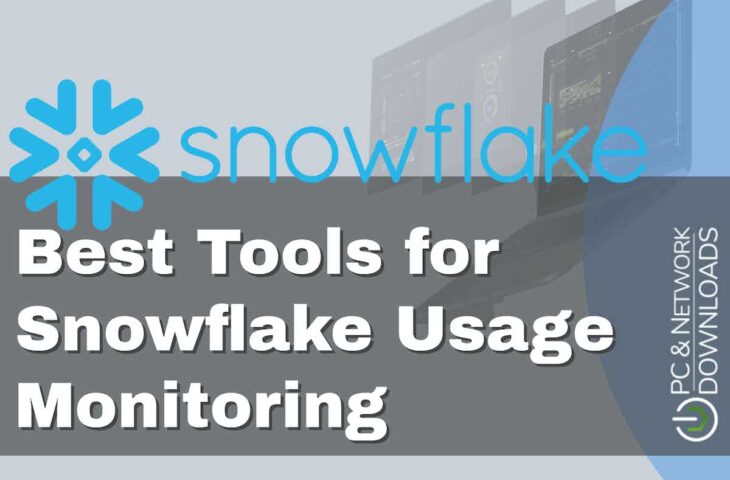
UPDATED: April 4, 2023
Snowflake’s data cloud platform is a perfect tool for any database analytics tasks you need to perform. The virtual warehouse system means that costs are entirely flexible, based entirely on your usage periods. However, this also means that it can be essential to optimize your usage to prevent overrunning or unintentional costs.
Snowflake, as a standard, doesn’t include any inbuilt solution to this problem (though you can visualize the usage data yourself, see the last mention on our list), meaning you probably need to find a third-party solution to check your data usage.
Here is our list of the best tools for Snowflake usage monitoring:
- Datadog Includes a full suite of enterprise-grade tools that allow you to visualize and monitor your Snowflake usage data properly. In addition, the included forecasting tools included in the Enterprise version make cost management and credit allocation simple.
- Tableau Boasting seamless integration, this solution is best for quick installation while still providing the expected usage and cost monitoring features.
- New Relic A robust solution with flexible pricing, including a completely free version for use cases on a budget. Despite the free label, the platform still comes with all the bells and whistles of premium solutions.
- DataSunrise A security-focused solution provides you with the means to track all login attempts and be alerted when your data security might have been compromised.
- Qlik With the Qlik Sense feature, you can fully customize your integration to provide the most seamlessly personalized monitoring dashboard on this list.
- Looker A premium product that can be expanded upon includes Snowflake integration with an open-source plugin, providing excellent usage monitoring with lots of customizable elements.
- Microsoft PowerBI A widely flexible and completely free solution that requires a fairly involved installation and integration cut down massively on expected costs.
- Snowflake Standalone All usage data is included within an inbuilt database within Snowflake, meaning you can access and export the data yourself without third-party tools.
This article runs through eight third-party products (and includes some details on using Snowflake on its own) that you can use to monitor your usage. These products also come with other benefits, such as security checks and performance metric comparisons that might be worth looking into to get the most out of Snowflake.
Snowflake has a unique pricing model based purely on usage, so here are nine tools you can use to monitor your warehouse activation times and user data.
The Best Tools for Snowflake Usage Monitoring
Our methodology for selecting Snowflake usage monitoring tools
- We reviewed various Snowflake monitoring tools and analyzed the options based on the following criteria:
- Support options for Snowflake environments
- Support for other systems outside of Snowflake
- Reporting and alert capabilities
- The ability to monitor Snowflake overtime
- Graphical interpretation of data, such as charts and graphs
- A free trial period, a demo, or a money-back guarantee for no-risk assessment
- A good price that reflects value for money when compared to the functions offered
1. Datadog
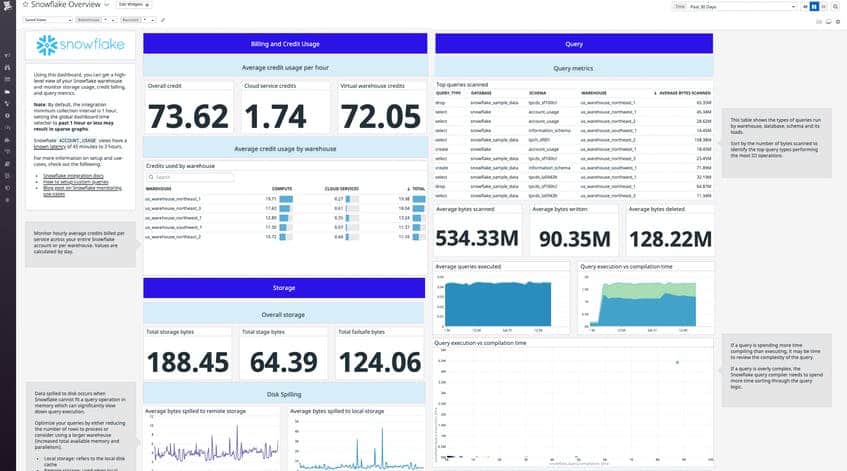
Datadog can be fully integrated with Snowflake’s architecture to utilize both solutions’ robust features, including usage monitoring. By accessing the fundamental integrated data within Snowflake, Datadog can compute your costs based on active usage time. You can also use Datadog’s tag-based analysis systems better to understand usage by user, role, or warehouse.
Key Features
- Data usage monitoring
- Cost analysis with projections
- Storage optimization
- Misconfiguration detection
- Visualization dashboard
Datadog’s forecasting tools can also provide usage and cost monitoring projections so you can plan your future Snowflake credit allocations. This solution is perfect for detailed analysis of usage data in an enterprise-level environment, especially with the professional approach to data monitoring that Datadog can provide.
Pros:
- Has one of the most intuitive interfaces among other network monitoring tools
- Cloud-based SaaS product allows monitoring with no server deployments or onboarding costs
- Can monitor both internally and externally giving network admins a holistic view of network performance and accessibility
- Supports auto-discovery that builds network topology maps on the fly
- Changes made to the network are reflected in near real-time
- Allows businesses to scale their monitoring efforts reliably through flexible pricing options
Cons:
- Would like to see a longer trial period for testing
Datadog offers a full 14-day free trial that is great for testing out the Snowflake integration for a reasonable period. However, for the Snowflake integration, you’ll at least need the essential Datadog agent provided by the Infrastructure solution. In addition, the Free version can handle up to 5 hosts but doesn’t include any crucially valuable features like data forecasting. For that, you’ll need the Enterprise version, which costs $23/host per month.
2. Tableau
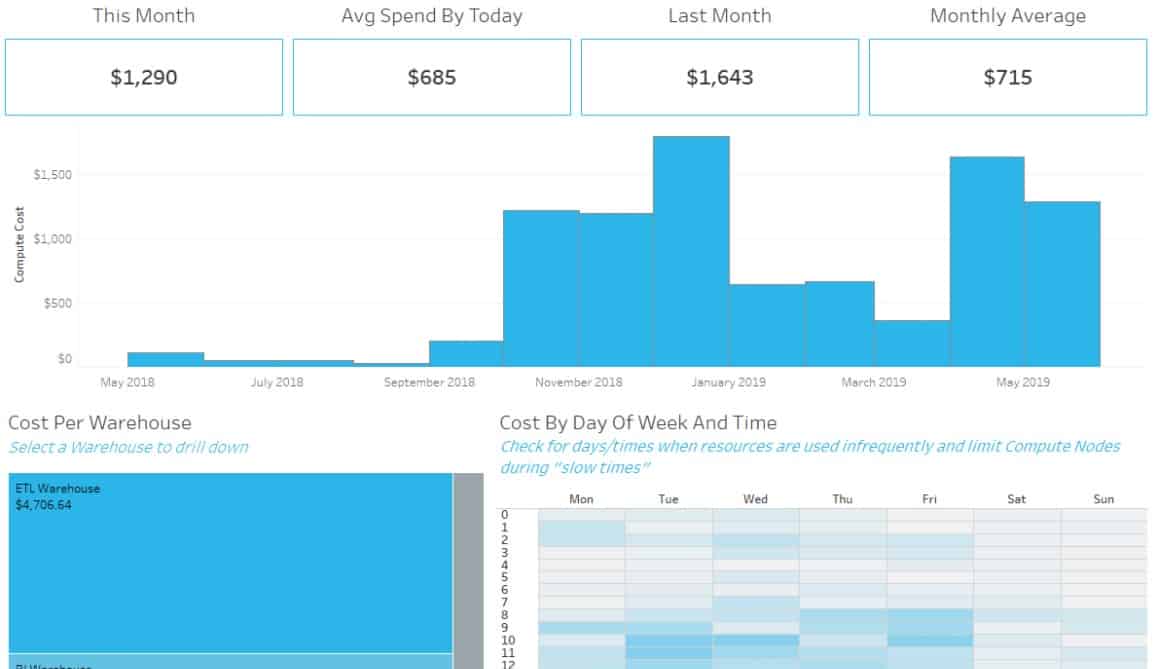
Tableau provides several systems that you can use to monitor usage data on your Snowflake virtual warehouses. Using the platform, you can create comprehensive dashboards that compute overall costs and provide performance monitoring criteria. You can also set up data-driven alerts to proactively monitor usage and warn you when costs exceed predicted values.
Key Features
- Comprehensive dashboards
- Cost analysis by user data
- Seamless integration
- User-filtering
- Security and performance alerting
Tableau usage monitoring is dashboard-driven primarily, but the integration happens seamlessly, and the valuable Snowflake monitoring dashboards are included as standard. Additionally, user-based filters and alerting are included to expand your monitoring capabilities.
Pros:
- Offers a fast and easy integration into your Snowflake environment
- Provides cost and usage monitoring features out of the box
- Features a simple interface
Cons:
- Would like to see a longer trial period for testing
Tableau offers a free 14-day trial of their platform where you can test out the seamless integration. Beyond the free trial, you can purchase licenses based on the desired purposes of a given user. For example, a Creator license grants someone the ability to connect data and publish custom dashboards (so you’ll need at least one of these for the integration).
A Creator license costs $70 per month, while an Explorer (can edit existing dashboards) costs $42. A simple Viewer license grants read-only access to the data and costs $15 per month. Using these three license options, you can customize the exact license costs you need based on what your users need to achieve on the platform.
3. Talend
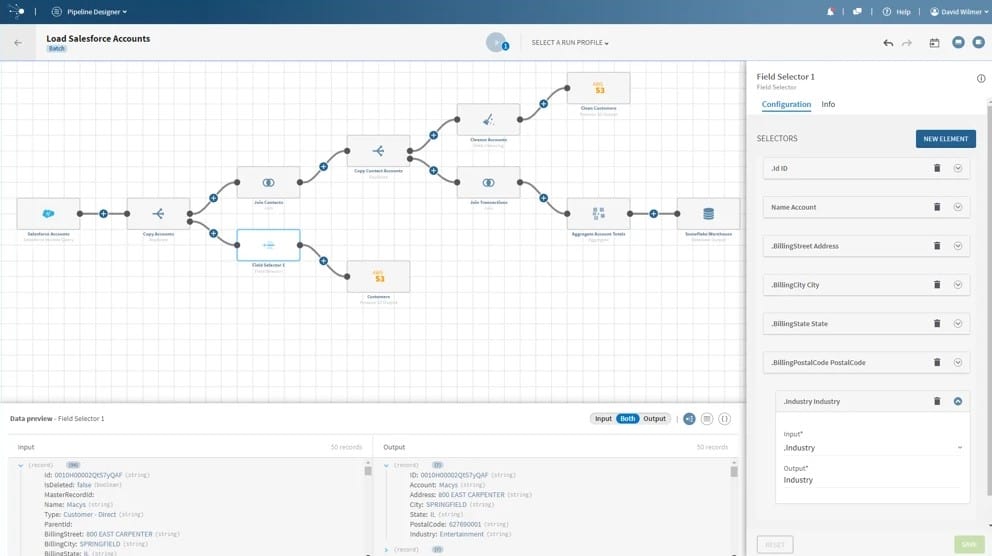
Talend is a professional enterprise-grade data analysis platform with an inbuilt suite of tools ready-made for integration with Snowflake. In addition, Talend has partnered with Snowflake to easily create connected trial accounts through a tailor-made partner program.
Key Features
- Partnered with Snowflake
- Seamless integration
- Data reliability monitoring
- Usage and costs checking
- Error detection
Because of their close connection, the integration is quick and seamless. Through the Talend platform, you can assess the reliability of your data using queried metrics and error checking to identify issues in real-time. In addition, You can project costs on the platform to show your exact usage considerations and plan for the future.
Pros:
- Offers Snowflake monitoring as well as other data analysis tools
- Provides Snowflake tailored monitors and dashboards
- Is highly intuitive and easy to use
- Has use well beyond Snowflake monitoring
Cons:
- Better suited for larger deployments and enterprises
Talend has a free trial available for you to test their product and see how the integration is handled. They have four products that scale based on features and capacity requirements, from small to enterprise businesses.
For exact pricing on each product, you’ll need to contact their sales team directly for a personalized quote on price.
4. New Relic
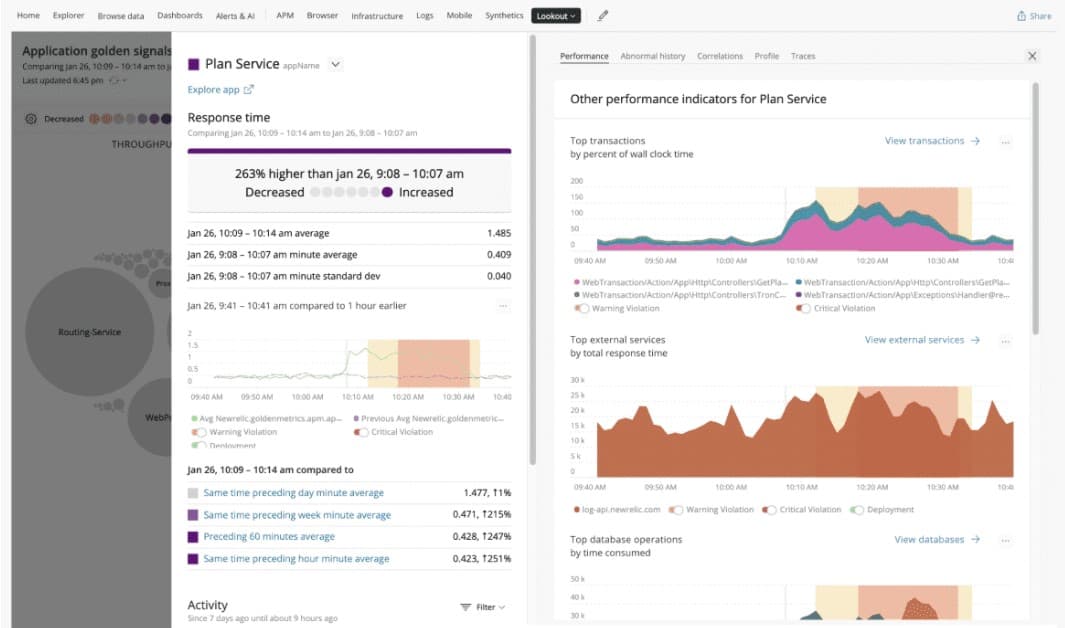
New Relic is a good solution if you need Snowflake usage monitoring on a budget. Their flexible pricing means they offer a completely free option while offering Pro and Enterprise choices for larger businesses. Regardless of your choice in pricing, the product provides in-depth Snowflake monitoring tools that can help you keep track of costs.
Key Features
- Variable pricing model
- Detect warehouse performance issues
- Security reporting
- Monitoring alerts for custom queries
- Cost analysis via user data
New Relic also has a suite of alerting tools for detecting anomalous issues. These issues could include faulty or incorrectly assigned data or even security issues like failed logins and unauthorized change requests.
Pros:
- Certified for Microsoft Azure monitoring
- Uses anamoly detection to highlight abnormal behavior in your Azure environment
- Uses simple but intuitive admin dashboards
Cons:
- Better suited for small to medium-sized Azure networks
New Relic is Free for a single user for up to 100GB/month of data. The Standard version expands users to five, while the Pro version supports many full-access users. For pricing, you’ll need to contact the sales team at New Relic for your personalized quote.
5. DataSunrise
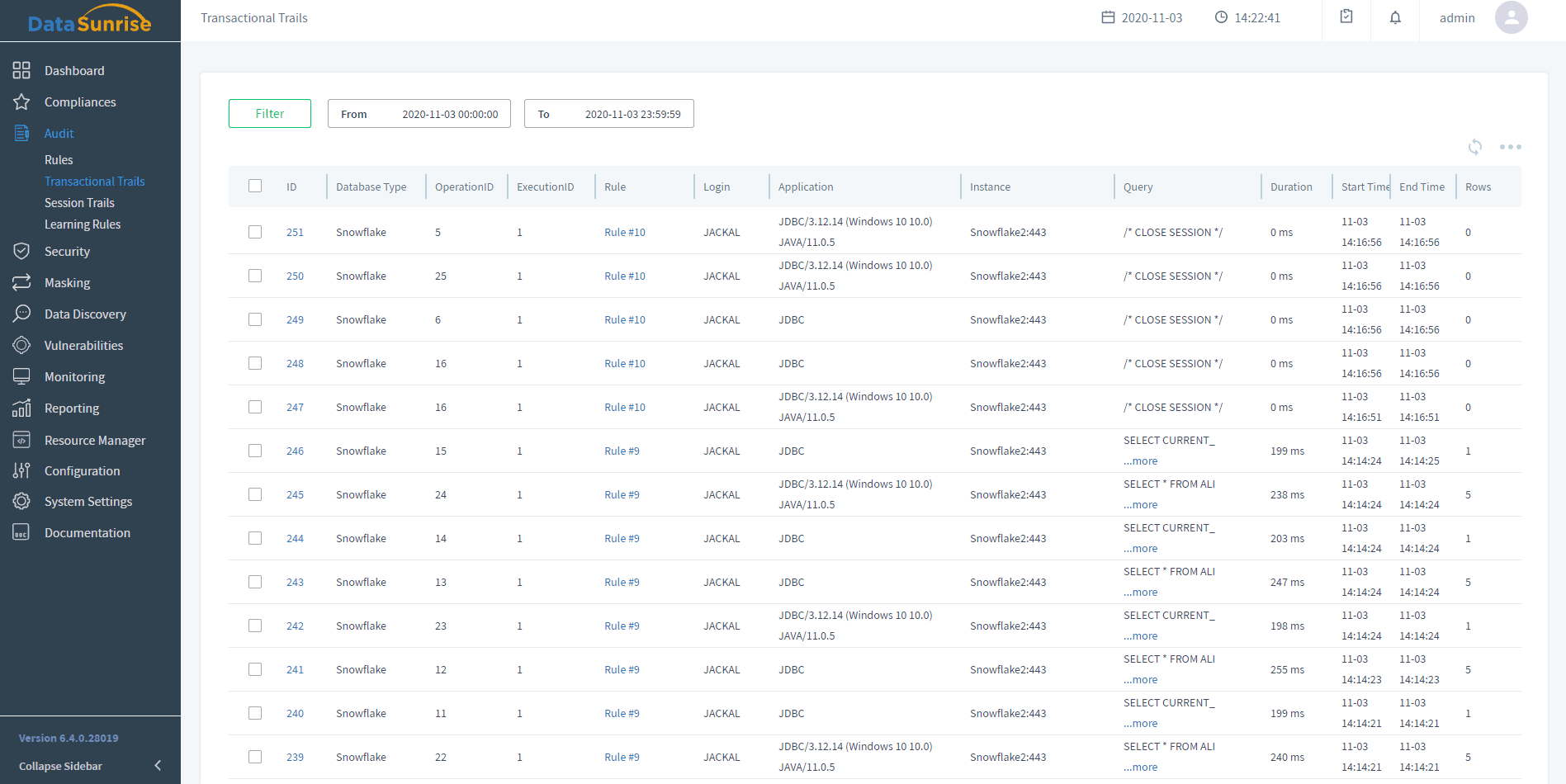
By employing the DataSunrise Security Suite, you can monitor database traffic and queries across all of your Snowflake integrated databases. Specifically, using the Activity Monitoring tool, you can detect SQL injections and suspicious access requests. In addition, the entire session data, including the IP address and hostname of those who access the database, is readily available.
Key Features
- Session data recording
- Security rules and restrictions
- Database error reporting
- Authorization attempt logging
- Data query monitoring
The focus of this solution is primarily on security concerns as opposed to strictly checking usage and cost analysis. While you can effectively use monitoring metrics to calculate the costs yourself quickly, these assessments need to be done manually and aren’t included in the application.
Pros:
- Simple yet intuitive interface
- Can detect and alert to security and compliance violations
- Records and aggregates database and session data
Cons:
- Pricing is based on usage hours which can take time to accurately estimate
The DataSunrise Security Suite can be downloaded from the website on a free trial basis, while the average cost of the platform is around $0.20 per hour beyond the trial period. Therefore, this solution is best selected if you plan to get your cost analysis metrics using another method, and your primary concern is database access security.
6. Qlik
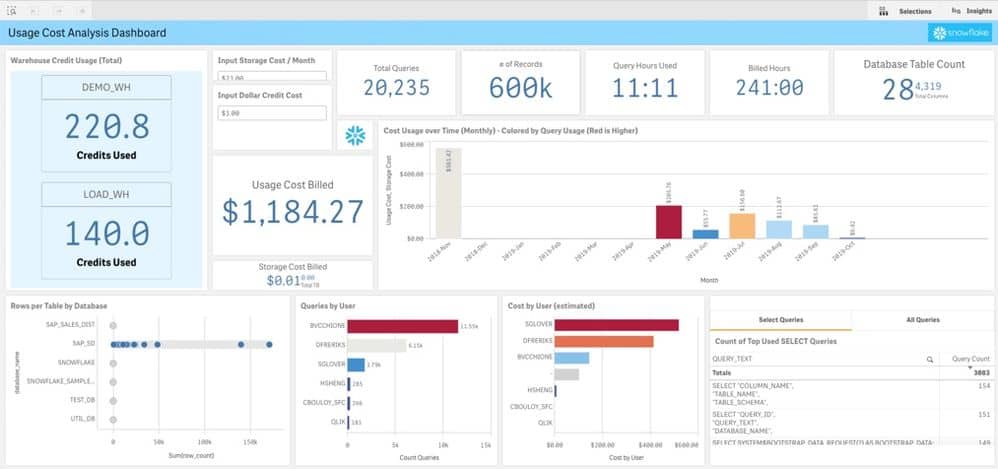
Qlik is an enterprise-level data analytics platform with some of the most comprehensive integration features of anything on this list, and Snowflake is one such fully integrated solution. In addition, the Qlik Sense component allows you to visualize data integration processes, making the installation smooth and highly customizable.
Key Features
- Smooth, highly customizable integration
- Usage and performance data
- Customizable dashboards
- Security checks with geoanalytics
- Auditing and reporting suite
The dashboards can be customized to show usage and cost information and projections that make credit allocation easier. There is also a geoanalytics page that displays where login attempts are made, drastically improving security readiness. Additionally, you can display detailed information regarding your query speeds and erroring with the included performance and optimization view.
Pros:
- Highly customizable admin dashboard – great for NOCs
- Designed with enterprise data management in mind
- Offers widget for cost estimates and Snowflake usage
- Feature robust reporting and auditing templates
Cons:
- Not ideal for smaller networks
Qlik has a Business version available for $30/user per month and an Enterprise version that increases the data capacity for global considerations. First, however, you’ll need to contact the Qlik sales team for a personalized quote.
Additionally, for the smooth integration of Snowflake, you’ll need to purchase the Data Integration solution. This additional cost can mean a notable increase in the pricing, so be aware of this necessary extra purchase. The Business version and the Integration suite have a free trial available to test out the features yourself.
7. Looker
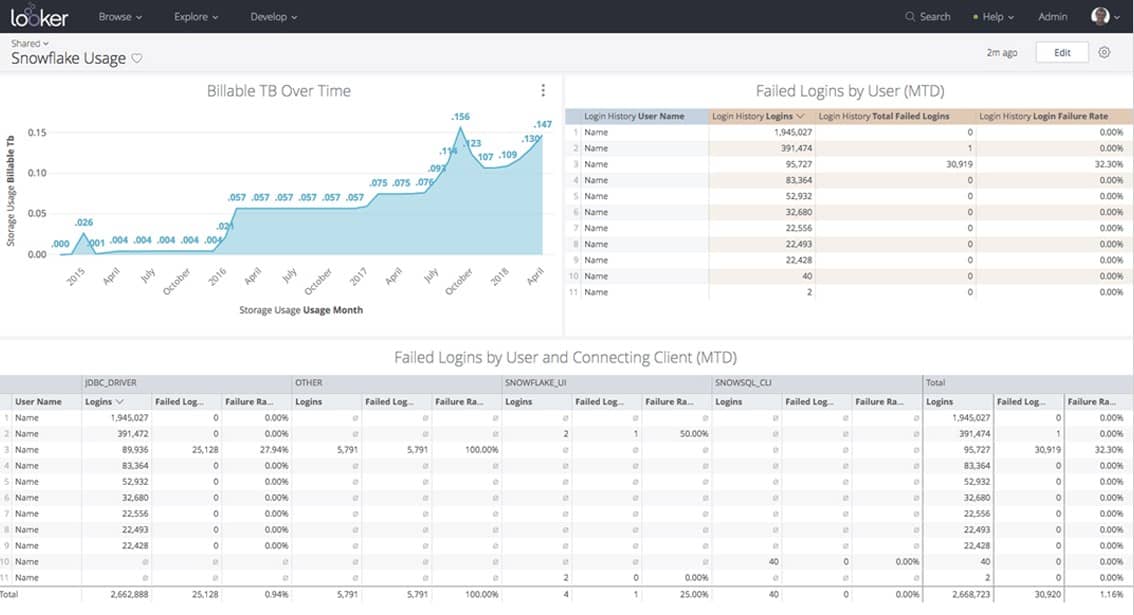
By using an open-source addon for the Looker platform, you can integrate Snowflake into your analytics. This provides comprehensive insights to aid in deploying and managing your Snowflake instances, including usage and cost reporting.
Key Features
- Open-source addon for a premium product
- Identify performance metrics
- Cost analysis features
- Custom dashboard
- User restrictions
The solution allows you to produce a dashboard that shows important Snowflake information front-and-center while also giving you the means to drill down into the data and identify usage, performance, and security metrics. In addition, you can use Looker’s platform to place your most extended running queries or compare costs based on specific virtual warehouses, among other things.
Pros:
- Completely open source and transparent platform
- Uses a simple user interface to display usage and cost
- Can restrict access on a per user basis
Cons:
- Less visual than competing products
While this addition doesn’t come as standard with Looker, the open-source development means it is open to tweaking for your setup if you have the means and the know-how. You’ll need to contact Looker’s sales team for a personalized quote on pricing.
8. Microsoft PowerBI
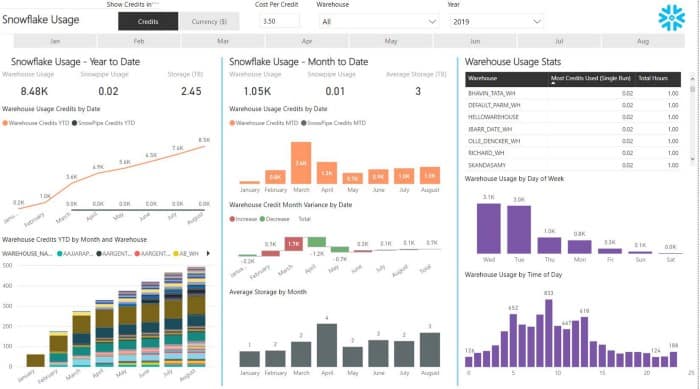
Microsoft’s PowerBI is a simple BI tool used by a substantial number of industry professionals for their analytics purposes, and it can be integrated with Snowflake to display user data. In addition, someone has developed a plugin to shortcut much of the work for yourself. However, a fair amount of installation work is still required to get your Snowflake warehouses communicating with PowerBI.
Key Features
- Robust BI platform
- Hefty installation, shortcutted with open-source assistance
- Usage metrics
- Customizable dashboard
- Free, with a premium version
What makes PowerBI such an enticing solution is the fact that it is free. You can feasibly fully integrate your Snowflake setup with PowerBI using the GitHub scripts and installation instructions for no cost. However, the product does have several premium features included in a Pro version that you may consider depending on your preferences.
Pros:
- Features hundreds of pre-made templates
- Works well across Microsoft products
- Supports complex flows for advanced automation
- One of the most popular data management platforms
Cons:
- Best suited for small to medium-sized businesses
PowerBI works on any device running Windows 10 or Windows Server. The primary product is completely free forever. The Snowflake integration should work without needing the premium features- however, if you want to upgrade, it costs $9.99 per user per month for the Pro version.
9. Snowflake Standalone

At its core, Snowflake is a data processing and analysis tool. All of the usage, cost, performance, and security information that all of the above integrations use is accessible even without third-party tools. If you don’t have the budget or the means to rely on an additional solution, then it's still possible to monitor your data usage without one.
Key Features
- No additional costs
- No additional installations
- Export to any other tool manually
The database containing all of this information is simply called SNOWFLAKE. This page from the documentation runs through all of the individual data variables that you can use to monitor your usage. This manual method isn’t ideal since the information isn’t especially human-readable. Still, just like any other Snowflake database, it can be exported and uploaded into whatever visualization tool you might need.
Pros:
- No additional cost
- No need for integrations or APIs
- Can easily output data as a CSV – good for manual processing
Cons:
- Not the best or more intuitive tool on the market
Since you’re already using Snowflake, there are no additional costs required to access your data in this fashion. In addition, as mentioned above, the data can be exported to several other third-party tools not on this list- for example, and you might simply output it as a CSV file then load it into MS Excel or Access.
While this option can’t compare to the others on this list, it offers complete flexibility without extra steps or extra costs.
In Summary
The above article details eight methods for you to integrate Snowflake data into a third-party solution to help you visualize and monitor your usage data. The data you pull from Snowflake can help you check costs and plan future finances involving Snowflake’s platform. Some of the solutions can also help you check security, using login checks and even geoanalytics. Finally, other solutions can help you check performance using query times and error detection.
If you need a solution on a budget, you might consider using Microsoft PowerBI or New Relic as professional but cheaper products on this list. You also might consider simply finding and exporting the data directly from Snowflake, eliminating third-party products.
For an enterprise-grade solution, Datadog, Tableau, Talend, and Qlik all provide similar toolsets with slight differences between them in terms of capacity, cost, and minor features. Use our article to compare them briefly, then consider installing the various free trials to test out the best solution for you.
Snowflake Usage Monitoring Tools
What is Snowflake?
Snowflake is a cloud-based data warehousing platform that provides tools for storing and analyzing large volumes of structured and semi-structured data. Snowflake is designed to be highly scalable, elastic, and accessible, providing organizations with a platform for managing and analyzing data from various sources.
What is Snowflake usage monitoring?
Snowflake usage monitoring is the process of monitoring and analyzing usage data from Snowflake to identify usage patterns, trends, and anomalies. Snowflake usage monitoring provides insights into the usage of Snowflake by individual users, departments, or the entire organization, and can help identify areas for optimization, cost savings, and security improvements.
What are some popular Snowflake usage monitoring tools?
Some popular Snowflake usage monitoring tools include:
- Snowflake Usage Dashboard: A built-in tool provided by Snowflake for monitoring usage patterns and trends, including query and data access patterns, data storage usage, and user activity.
- Datadog: A cloud-based monitoring and analytics platform that provides tools for monitoring Snowflake usage, including query performance, usage patterns, and resource utilization.
- LogRocket: A tool that provides real-time monitoring and troubleshooting of web applications, including Snowflake-based applications, by recording and analyzing user interactions and logs.
- Looker: A business intelligence and analytics tool that provides insights into Snowflake usage patterns and trends, enabling better decision-making and collaboration.
- Splunk: A cloud-based data analytics and monitoring platform that provides tools for monitoring and analyzing Snowflake usage, including query performance, usage patterns, and security issues.



